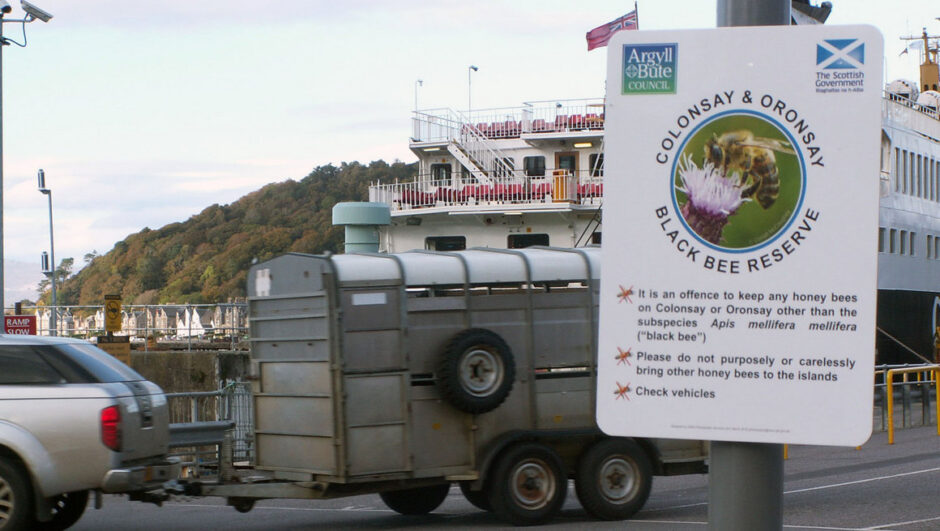(Apis mellifera mellifera) in the Hebrides, Scotland
By Andrew Abrahams
We are grateful to the author Andrew Abrahams and the editor of the American Bee Journal for permission to use this article.
Readers might ask, why on earth spend much of a lifetime conserving what most beekeepers perceive as an aggressive, unproductive race of honey bee — a race perhaps left behind by history? I was fortunate, often by chance rather than grand design, to gather up some pure remnants of Scotland’s native honey bee (Apis mellifera mellifera) in the late 1970s and since then I have managed over decades to improve this population in the isolation of the remote island of Colonsay, which lies 16 miles off the west coast of Scotland (see https://colonsay.org.uk).
In 2013, I was able to convince our Scottish Government to pass the required legislation to help protect this population for future generations.1 Readers might find this an interesting story!
Oyster farming took me to the small (ca 12 square miles) island of Colonsay in the late 1970s. I had no experience or interest in beekeeping. This changed on exploring a dilapidated barn on a neighbouring farm and finding dozens of old hives and nucleus boxes. Colonsay and the adjacent island of Oronsay, connected at low tides, had been used from 1946- 1966 as a queen rearing and breeding station for Black Bees. Joseph Tinsley, then the apiculturalist at the West of Scotland College of Agriculture, and a man well ahead of his time, was greatly concerned by the steady hybridisation of Scotland’s native Blacks, largely by Italian imports. In Scotland there had been no history of stock improvement, or dissemination of selected queens to the many small-scale, local beekeepers. Tinsley’s view was that the best way to compete with foreign imports was firstly to improve and then multiply up locally adapted stocks. Now that has a familiar “Darwinian” ring to it!
Colonsay and Oronsay gave him isolation and, importantly, enough bee forage throughout the summer months to maintain a large enough population from which to select and improve. He writes, “It is possible to improve the native strain considerably.”2 A local farmer, Niall McNeill, was trained in queen rearing. Queens and nucs were sent regularly to the mainland. In 1945, Eva Crane, Director of the International Bee Research Association in the U.K., recorded in her diary a visit to Colonsay and Oronsay and her interest in finding Black Bees on the islands, which were resistant to acarine mites (Acarapis woodi).3 It is clear that there were many “survivor stocks” from the acarine epidemic that had swept across the U.K. in the early 1900s.
During these last two decades there has been a growing momentum to conserve the pure races of Europe’s honey bees.4, 5 Beekeepers and scientists have watched with alarm the constant mixing of races, the dilution of inherited traits and the ultimate loss of valuable genetic material. These genetic resources have been derived from millennia of adaptation to specific environmental conditions. Now free trade, competition and consumer choice drive the machine! This prevailing attitude has pushed pure races of honey bees to the margins of most European countries. High mountain valleys, large forest parks and remote islands provide the isolated areas required for the protection of locally adapted honey bees. National and local legislation further try to protect these reserves. Slovenia is one rare exception, where nationally all bee imports are banned to maintain pure strains of Carniolan stock.
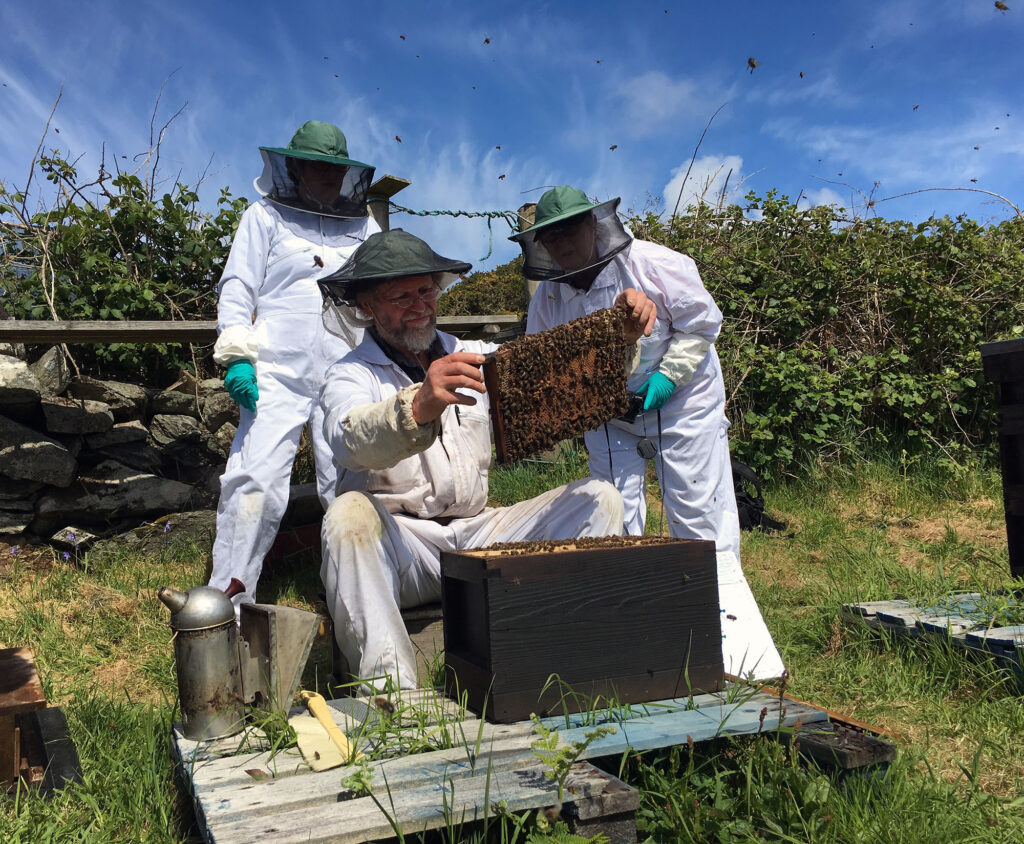
Agressive Blacks? 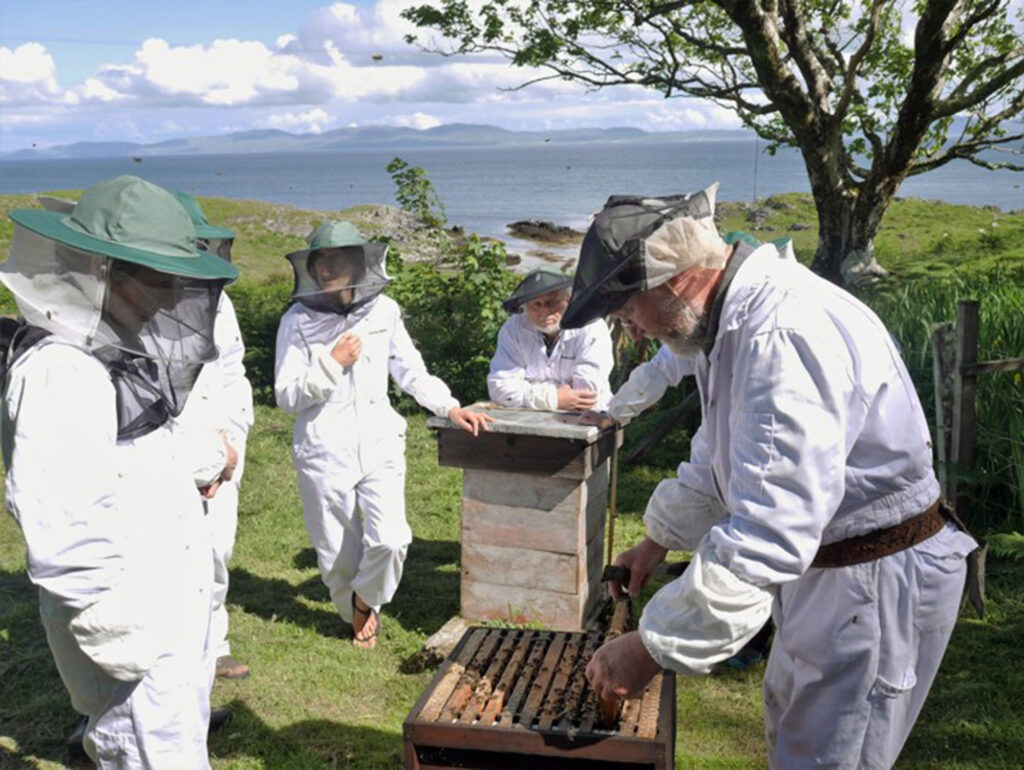
Scottish Native Honey Bee Society gathering for an inspection
Today, we still have populations of Blacks in Scotland, some more diluted by foreign imports than others. Many beekeepers see the worth of maintaining and improving their heritage by selecting and raising their own queens. Others would argue that it is easier and cheaper to import from abroad; after all, some think bees are bees are bees!
When asked about the Black Bee, many will repeat what they have read in books and journals: a defensive and aggressive race with low productivity, adapted to the colder, wetter climate of western and northern Europe where it evolved. First brought to the U.S. around 1620 by early settlers from Europe, these Black Bees have long, largely been replaced by imports of Italian, Buckfast and more recently Carniolan bees, and by the invasion of Africanised hybrids. However, four hundred years later, the genetic signature of those early imports is still well embedded in the stocks of wild (unmanaged) colonies living in the U.S. Seeley’s genetic analysis of the Arnot Forest survivor stocks, before and after the impact of varroa, show that around 20% of their genomes can be attributed to Apis mellifera mellifera.6
It is worth considering the opinion of a world-renowned bee breeder, Brother Adam of Buckfast. He was full of praise for the U.K.’s native bee: “This dark brown bee was the possessor of quite an extra-ordinary assembly of most valuable economic qualities. … These traits, extreme thrift, ability to fend for herself, longevity, hardiness, wing power and industry, which were such a marked feature of the English (and Scottish!) bee, can hardly be found together in the same concentration in any other race.” He also states clearly that the “acarine epidemic completely wiped out” the old English brown bee.7 Goodness, if he had just come north to Scotland or taken the ferry over to Ireland, he would have found plenty of “survivor stocks.” I have often wondered, what might have happened if Brother Adam had turned north and west instead of south and east, when he left the gates of Buckfast “in search of the best strains of bee”? What if he had stuck with and selected from acarine survivor stock? Stocks on which to use his incredible breeding skills. Perhaps the warmth of the Mediterranean and the sunshine of North Africa were a greater lure to ageing bones, than the grey of the Celtic fringe!
Early Days for a novice beekeeper. However, back to that shed on Colonsay and the empty hives. In the late 1960s Niall McNeill had retired to the neighbouring island of Islay and taken Colonsay’s stocks of Blacks with him. I could not find any wild stocks by the late 1970s, but back then I had an inexperienced eye. I was also inexperienced in many ways for remote living on an island with only three ferries per week and no public water supply or electricity. However, Colonsay’s very resourceful Gaelic community of around 120 kindly shepherded myself and family around many of life’s pitfalls. Keep away from the “expensive college” was always sound advice, quietly given! With this in mind before starting my beekeeping career, I worked for two summers with a bee farmer running 1,500 hives on the east coast of Scotland. Again, I took sound advice regarding the selection of stocks of bees that I was to take out to Colonsay. This came from Bernard Mobus, the apiculturalist at the North of Scotland College of Agriculture: Look carefully for native stocks that are able to take the harsh Atlantic weather out on the islands. Mobus had spent many years selecting and improving his Maud strain of native Blacks in an isolated area north of Aberdeen. A total of 14 colonies, and a further 16 queens from widely differing remote areas of Scotland and two from the Galtee Black Bee Breeders in Ireland, became the basis of today’s isolated stocks on Colonsay. This population, currently maintained at around 60 colonies, has now been isolated for almost 40 years. Geneticists have thoroughly analysed Colonsay’s stocks and found them to be of almost pure M lineage with very little introgression of C lineage.8, 9 Stocks are disease-free regarding varroa, AFB, EFB, Nosema apis and Nosema ceranae. Viruses, particularly DWV, are very hard to find with PCR analysis.10
During the ‘80s and ‘90s I was preoccupied with raising a family and also building a home and work sheds; no houses were available for rental. Life was very much hand to mouth, but beekeeping skills grew quickly. When bees are kept at the edge of their natural range of survival, beekeeping mistakes are quickly punished. Honey sales to a growing tourist market became a welcome additional source of income. Over the decades the bees and their keeper slowly adapted to their Atlantic environment.
Climate. Colonsay sits in line with Labrador and the Hudson Bay at 56 degrees north latitude. However, the warming currents of the Gulf Stream bless the west coast of Scotland and Ireland with mild, if wet, winters. Summer temperatures seldom rise into the 20s centigrade (68 F). Queen mating days (hours!) are at a premium. Wind is a constant, and salt burn from spring and summer Atlantic gales can decimate bee forage at any time.
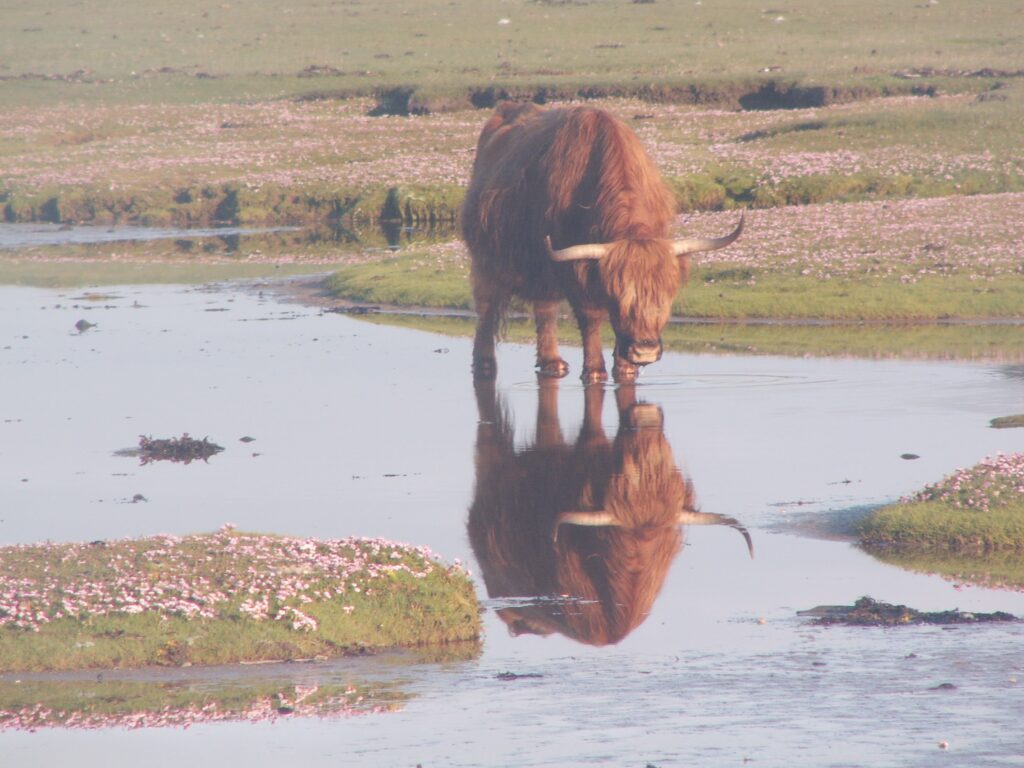
Sea Pinks and June’s reflections 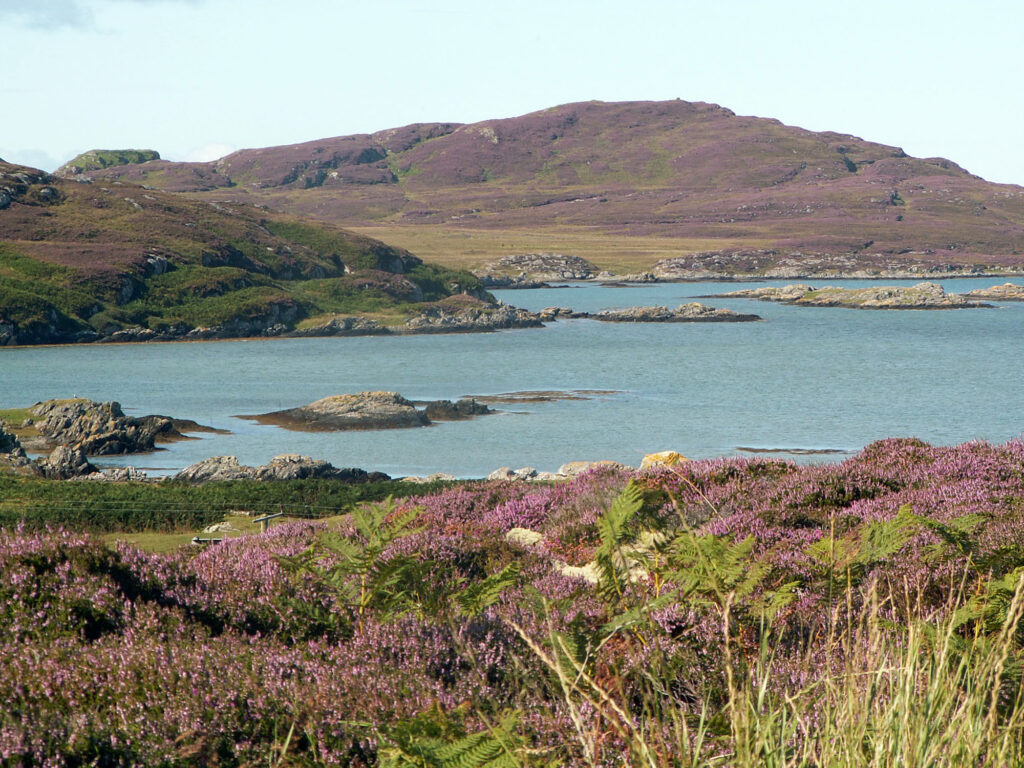
August heathers in full bloom
Colonsay’s Bee Forage. Sheep and cattle grazing greatly influence bee forage. Heathers dominate much of the bare, rocky hills and provide important grazing for sheep in winter and a wonderful honey crop for the bees in autumn. A reduced number of sheep, due to poor prices and farming cutbacks, has seen a return of much enclosed land to scrub — willow, gorse, blackberry and thistle. That old adage “poor farmers raise wealthy beekeepers” holds good. There are good pollen sources for bees throughout the year, from gorse in February right through to heathers in August and September. However, cold, wet weather can confine foragers to their hives for weeks. The Blacks’ adaptive trait of storing slabs of excess pollen gathered during good spells keeps queens laying over dearth periods. Interestingly, Tentorium, a very large Russian producer of bee products, selects and breeds Apis mellifera mellifera strains specifically to exploit this pollen hoarding trait. Bee bread is a much more valuable product than pollen and Tentorium has specialist machinery, incorporating miniature flails that strip the ensiled pollen pellets from brood combs.
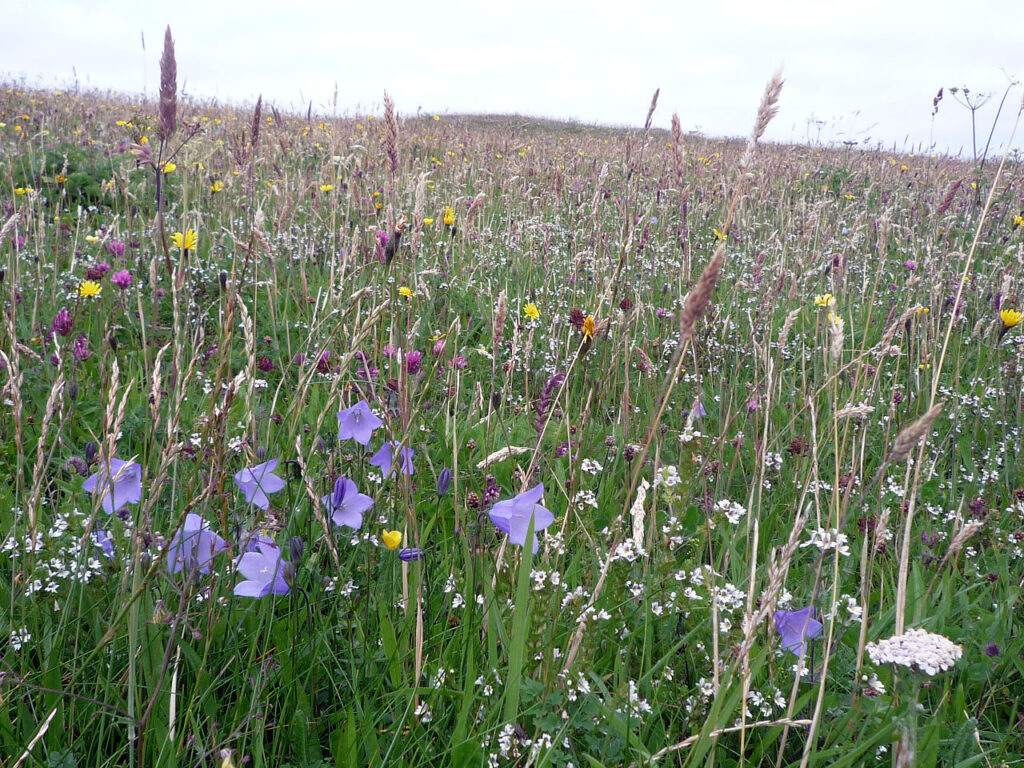
Wild flowers abound in the pastures, ditches and scrub areas of the island and also in the exotic woodlands planted out in the sheltered estate gardens. Particular to coastal islands are the sea pinks (Armeria maritima) growing along sheltered tidal shorelines. Also abundant in June are the Machair flowers. The Machair is the “fertile grassy plain” stretching inland from Atlantic beaches, which storm-blown sand helps fertilise every winter. The machair in bloom in June is a joy for bees and tourists alike. All these wild flowers, including wild thyme ( Thymus serpyllum) contribute to building and sustaining large bee colonies, which then exploit the late heathers. In good summers there can sometimes be surplus before the heathers. Colonsay’s multi floral honey is highly aromatic and of very high quality. Sadly, I was unable to benefit from Niall McNeill’s skills and his years of experience, as he died very suddenly. However, his words “a difficult crop to produce, boy, but a very easy crop to sell” stuck with me from the beginning.
Management System. Stock numbers on the islands are dictated by available pollen, especially spring pollen. Colonies can struggle to build up in late, wet and windy seasons. Eight apiaries widely scattered around the two islands shelter some 60 colonies and their overwintered nucs. Hives are not moved and apiaries have been selected for shelter and bee access to both summer and autumn flows. I am always surprised at how local foraging activity can be between the different apiaries on a small island.
Honey is harvested at the end of the heather flow in September. Depending on the season, the multi floral spring and summer nectars give about one third to one half of the crop. Heathers usually dominate the mix, but can fail completely some years due to rain. Stocks overwinter on at least 30 lbs. of honey. Wintering on heather honey is not a problem, as mild winters allow plenty of cleansing flights. Heather pollens can be vital brood food in March and April, if stocks are unable to forage early.
All queens are marked and clipped in April. Year-old and two-year-old colonies expand into a double brood chamber (British National brood box = 36 litres; Langstroth = 40 litres) and are normally given 2-3 honey supers above a queen excluder to contain swarming impulse. Queens that are 3-4 years old are held in single brood boxes to produce splits or are Demaree’d to produce queen cells and/or splits. These older stocks often produce supersedure cells. Normally all supersedure cells are harvested. A second and third crop of cells can then follow. These cells invariably produce the strongest queens. Virgins from these sources and also from grafting and dedicated cell raisers are mated from some 100 Apidea mini mating nucs. Careful record keeping of mated queens ensures queen lines are maintained. Colonsay offers the ideal isolation for an island mating station. However, the Hebridean islands are not the place to risk a pension on a queen rearing business!
Swarm inspections start around mid-June and finish at the end of July. To minimize colony disruption, colonies with double brood boxes are split, tipped upwards and inspected for cells on the frame bottoms of the top box. It has become fashionable amongst those wishing to keep bees “naturally” to limit the brood space and allow swarming to take place. This is seen as the bees’ “natural” behaviour. I applaud the need to return bees to the wild, particularly to build up the population of locally adapted survivor stock. However, if every beekeeper were held individually responsible for every swarm they release into neighbourhood buildings or trees, attitudes to swarm control might change. And that is the case on Colonsay! I am the only beekeeper on an island, whose economy now derives much of its income from holiday lets and second homes. Most of the public are very frightened of bees, and retrieving swarms from under old, slated roofs takes days of work. Breeding non-swarmy stock and making careful inspections for swarm preparations are a much better investment of my labour.
I would also question whether swarming is the natural or most common mode of queen replacement for the Black Bee, the race of northern climes. Swarming is highly risky and biologically expensive in northern latitudes. Seeley & Morse11 and also Morales12 indicate that around 75% of swarms at 46 degrees north die in their first winter. Supersedure would seem to be a much safer alternative to have available in one’s genetic tool kit. I have found supersedure to be a heritable trait, with some lines superseding up to five generations in a row. I commonly find mother and daughter laying together. Good luck, however, is important in providing good mating days, when required by the supersedure virgin. Virgin viability for Black bees can stretch to a month after hatching, rather than the predicted two weeks for southern races. Being able to take a beekeeping class through a hive with three generations of “queens” running together (old marked queen, autumn drone layer and spring virgin) packs a lot of teaching into one demonstration! Local vicinity matings, rather than matings at distant drone congregation areas, also seem to be an adaptive trait of the Black Bee. Temperatures on Colonsay seldom get above 20 C (68F) and matings at 16/17 C (61-63 F) are common.
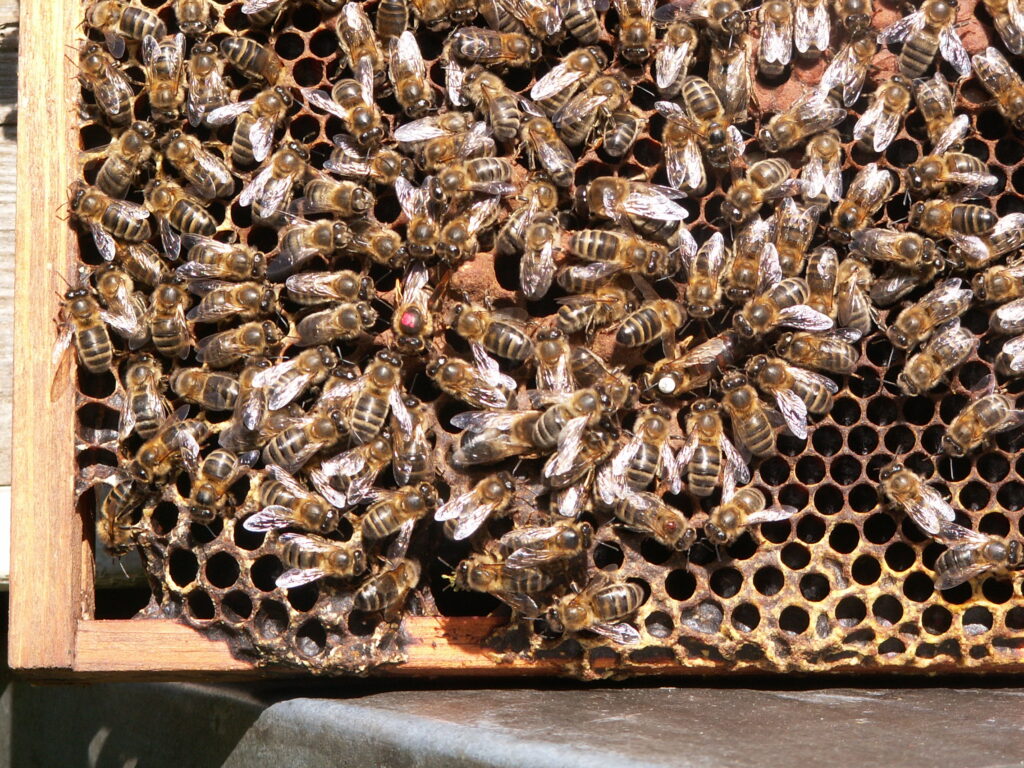
Breeding improvement of small, isolated populations. The demise and genetic loss of the minority bee races across Europe has largely been due to their historic lack of selection and improvement. Small scale local beekeepers have not had the resources or inclination. It has always been much easier to import improved stock from elsewhere. I would argue that genetic conservation and stock improvement are not incompatible. Local beekeepers using “improved stock” are then much more likely to maintain and further spread these genes into the local gene pool and back into the wild, as survivor stock.
So, how much improvement is possible within a small 60-colony population, without the loss of genetic variability and subsequent problems this may bring? Over the past 40 years improvements on Colonsay have been considerable, particularly in terms of gentleness and non-swarming.
Breeding Strategy. The genetic base of Colonsay’s population came from 30 imported queens, each mated by, lets say, an average 10 drones. Some 300 queens might then have contributed to Colonsay’s genetic mix. This number could be considerably less, if purchased queens had multiple brother matings and also from initial loss of queen lines due to my poor, initial beekeeping skills. From the outset, to maintain that diversity, I have culled the worst, rather than bred from the best. Each apiary is considered in isolation; 3-5-year-old “breeder queens” replace themselves, and also one or two of the worst one-year-old stocks. In contrast to large-scale, carefully monitored and highly selective breeding programmes, improvements by this method can only be small and incremental. However, over the decades progress has been good and crucially there have been no problems associated with genetic loss or loss of sex alleles. Brood patterns are solid and DNA analysis has further confirmed continued presence of initial sex alleles.13, 14
Breeding Improvement Analysis. I am often asked by the scientific community to validate and quantify stock improvements. I was even asked by one visiting breeding professional to show him my stud book! No, I think the quickest way to evaluate a small closed population is to look at the average and find the worst. Gloves are no longer required, little smoke is used and many inspections can be done without a veil. This experience is similar to other populations of pure Blacks across the world.
Disease. I was very fortunate to be able to bring disease-free stock out to the islands before varroa and Nosema ceranae were brought into the U.K. An almost virus-free population is a valuable resource for scientists researching honey bee viruses and their impact on honey bees when associated with the varroa mite.15, 16
Chalk brood (Ascosphaera apis) is perhaps the only bee disease that might concern Colonsay’s bees; always present, particularly in cold, late springs. Bee milk can be thin if fresh pollen is scarce, and undernourished larvae easily succumb. Chalk brood might also be the consequence of a survival trait of the Black Bee — “poor thermoregulation.” Spring on the Northern European fringe is very much a start-and-stop affair, unlike spring in Continental and Southern Europe (read Carniolans and Italians). Maintaining constant temperatures over an expanding brood nest can be a very expensive drain on dwindling winter stores. Poor thermoregulation and sacrifice of the exterior of the brood nest, as the cluster tightens, is an adaptive trait of northern bees. Is chalk brood perhaps the evolutionary cost of colony survival at the fringe? Most colonies outgrow chalk brood when conditions improve.
The bee louse (Braula coecae), now absent in most of the world’s honey bee populations, still makes a living on Colonsay. They are never much of a problem, apart from disfiguring cut comb sections. I have noticed large numbers of lice transfer to queens in late autumn. Nurse bees are no longer feeding brood and perhaps the queen becomes the main source of mouth-to-mouth feed transfer, from which the louse can steal a meal.
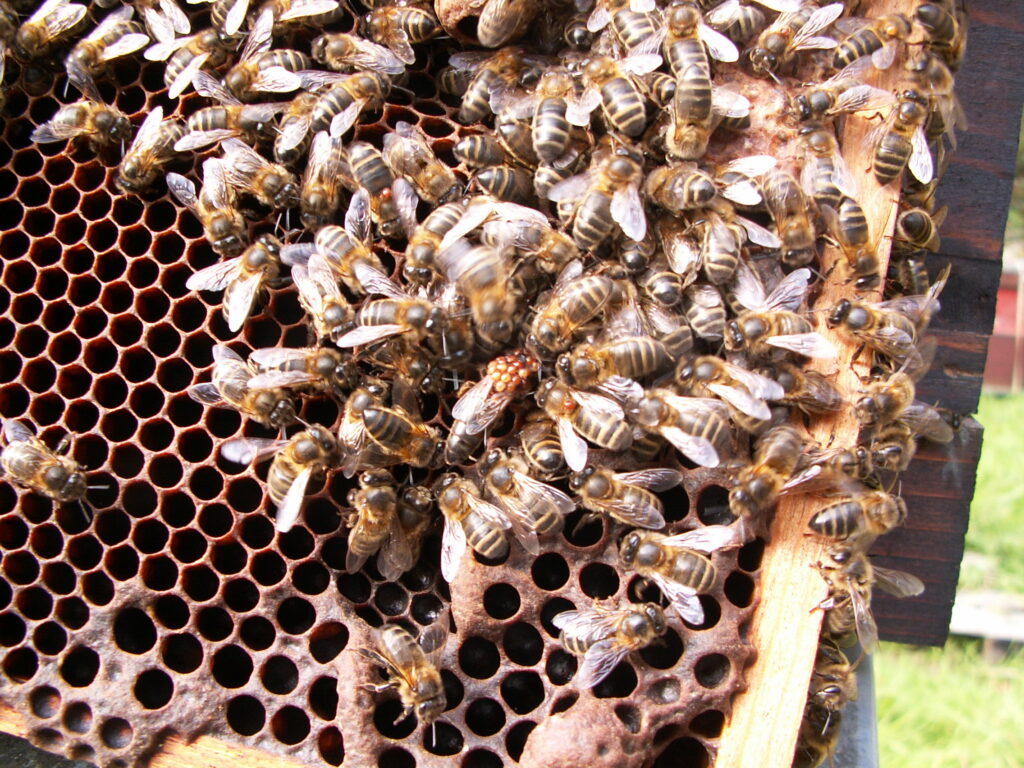
Conclusion. As I write this in early April, the COVID-19 virus has pitched Colonsay back to the 1970s, when this story began. Ferries sail from the mainland on only two days per week and are strictly limited to islanders. This small community must again turn to its own resources and away from mainland reliance. Surely the spread and worldwide impact of this virus will teach the world beekeeping community a valuable lesson. If not, the spread of the next deadly bee virus, along with the Tropilaelaps mite, seems a certainty.
Acknowledgement
The author would like to thank Tom Seeley for his encouragement to write this article for ABJ after his visit to Colonsay in summer 2019, and for kindly reviewing the original draft.
References
- Wildlife and Natural Environment (Scotland) 2011 Act. The Bee Keeping (Colonsay and Oronsay) Order 2013
- Tinsley J. Experiments in the Breeding of Native Strains of Bees. Lecture given to the Central Association of British Beekeepers Association, Gloucester, 1956
- Eva Crane Diaries, IBRA Library. Carreck N. IBRA Science Director pers com.
- Paxton,R.J.,Brown M.J.F., and Murray T.E. 2009. Special Issue on “Bee Conservation” Apidologie 40: 193-416
- M Alice Pinto et al. 2014 Genetic Integrity of the Dark European honeybee (Apis mellifer mellifera) from protected populations. Journal of Apicultural Research 53(2): 269-278
- Seeley T. D. et al. A survivor population of wild colonies of European honeybees in the northeastern United States: investigating its genetic structure Apidologie 46 654-666 (2015)
- Adam, Brother (1983) In search of the best strains of bees. Northern Bee Books; Hebden Bridge, UK. 199-201
- Jensen Annette B. et al. Varying degrees of Apis mellifera ligustica introgression in protected populations of black honeybee, Apis mellifera mellifera, in northwest Europe. Molecular Ecology 14, 93-106 (2005)
- Pinto Alice M. et al. Genetic Integrity of the Dark European honey bee (Apis mellifera mellifera) from protected populations: a genome-wide assessment using SNPs and mtDNA sequence data Journal of Apicultural Research 53(2) 269-278 (2014)
- Martin S.J., Ball B.V., Carreck N.L. The role of deformed wing virus in the initial collapse of varroa infested honey bee colonies in the UK Journal of Apicultural Research 52,(5) 251-258 (2013)
- Seeley,T.D., Morse, R.A. The natural nest of the honey bee (Apis mellifera) Insectes Soc. 23, 495-512 (1976)
- Morales G.S. 1986 Effect of cavity size on demography of unmanaged colonies of honey bees (Apis mellifera L.) MSc Thesis, University Guelph, Ontario
- Palmer K. A., Jensen A. B. (2001) Beekeeping and Biodiversity in Europe (BABE) research Pers. Com.
- Theisen Schmidt S. 2011 Inbreeding in an isolated population of Black Bees on the Scottish island of Colonsay. Bachelor Project, Copenhagen University, Denmark
- McMahon, D.P., Natsopoulou, M.E., Doublet, V., Fürst, M., Weging, S., Brown, M.J.F., Gogol-Döring, A., Paxton, R.J., 2016. Elevated virulence of an emerging viral genotype as a driver of honeybee loss. Proceedings of the Royal Society of London B: Biological Sciences 283, 20160811. DOI: 10.1098/rspb.2016.0811
- Ryabov et al., 2014 A virulent strain of Deformed Wing Virus (DWV) of Honeybees (Apis mellifera) prevails after Varroa destructor-mediated, or in vitro, transmission. Plos Pathogens. 10,6,21p., e1004230
Andrew Abrahams is both an oyster and bee farmer. He has kept bees commercially on Colonsay for 40 years and has wide experience of honey production and queen rearing. His background is in agriculture with a BSc (Hons) Degree in Agriculture and is a Master Beekeeper with the Scottish Beekeepers Association. He has teaching experience in both beekeeping and agriculture. Colonsay is home to one of Europe’s few populations of pure Black Bees (Apis mellifera mellifera), the U.K.’s native honey bee. The bees on Colonsay are managed for commercial honey production and queen rearing, but are also of unique interest to honey bee conservationists and scientists studying bee diseases. The 50-60 stocks of Black Bees on Colonsay are self-sustaining. Years of selection have produced a productive and gentle strain. In 2013 the Scottish Government passed an Order under the Scottish Wildlife and Natural Environment Act (2011) WANE that will ensure Colonsay remains a Reserve for Apis mellifera mellifera.
© 2020 American Bee Journal; reproduced with permission

